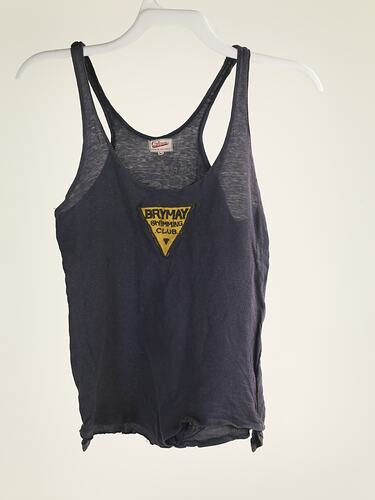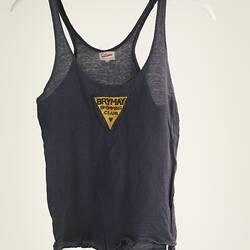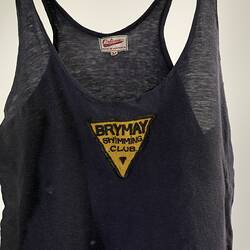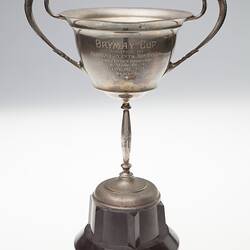Summary
Bathing costume worn by Miss Alma Pace (later Mrs Alma Merritt) during the 1930s, when she worked at the Bryant and May match factory in Richmond in the 1930s. It was made by Ortona Knitwear
Physical Description
Dark blue women's cotton one piece bathing costume, with a yellow triangular logo on the front with `Brymay Swimming Club' embroidered on it. The costume has a narrow back, thin shoulder straps, and short legs. On the top of the inside back is a white fabric maker's label embroidered `Ortona Knitwear'.
Significance
The bathing costume is significant due to its design, which reflects an important development in the evolution of swimwear. As ideas about modesty changed, the early 1930s saw the introduction of the raceback design which was incorporated into men's and women's swimsuits. It consisted of low cut armholes and a narrow back panel, enabling the swimmer's arms to move more freely. They also moved away from the traditional woollen fabric into elasticised cottons which was much lighter when wet.
The bathing suit is also significant due to its relationship to the iconic Melbourne landmark the Bryant and May Factory. The complex was located in Church Street, Richmond. It was constructed in 1909 as the Empire Works to a design by prolific Melbourne architect William Pitt. It was purchased soon after by British safety match manufacturer Bryant and May, who had been operating at two smaller sites in Richmond since 1885. They significantly expanded the building adding an additional level and the landmark clock tower.
Bryant and May were unique in that they operated as a model factory providing workers with conditions and amenities which even today seem generous. These included a dining hall and sports facilities such as a tennis court and bowling green which were constructed in the 1920s, and reflected the Quaker principles of the original English founders.
Bryant and May ceased Australian match manufacture in the early 1980s as a result of import competition. Their iconic Redheads matches are now imported from Sweden. The complex has since been converted for use as offices and showrooms but is extremely well preserved. It is listed on the Victorian Heritage Register
More Information
-
Collecting Areas
-
Acquisition Information
Donation from Ms Michelle Lemire, 28 May 2007
-
Date Made
-
Organisation Symbolised
-
Manufacturer
-
Inscriptions
Text: 'BRYMAY/SWIMMING/CLUB'.
-
Classification
-
Category
-
Discipline
-
Type of item
-
References
Email from the donor relating to the swimsuit's history (copy printed out for Supp File); Victorian Heritage Register listing for the Bryant and May factory complex (copy printed out for Supp File); City of Yarra Heritage Review, Building Citations (copy printed out for Supp File)
-
Keywords



